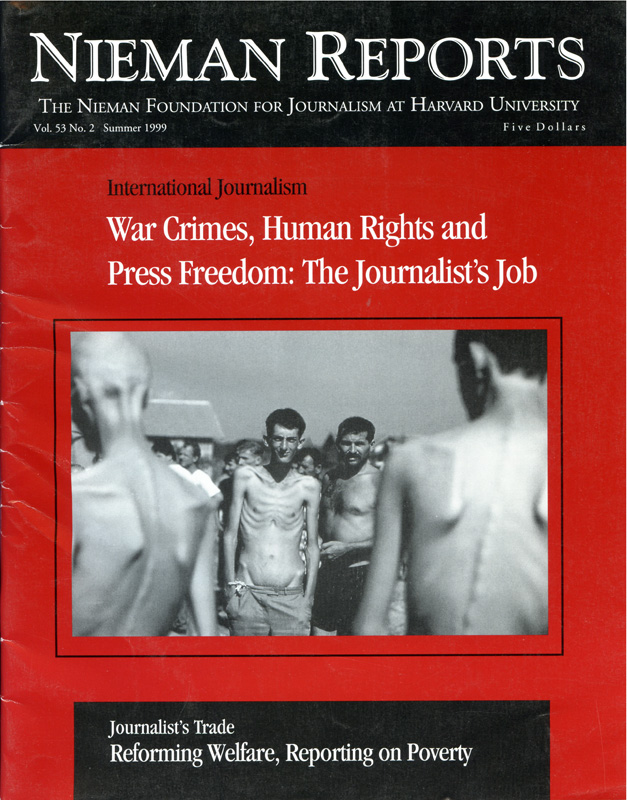
Em Pen consoles Anthony, one the grandchildren whom she takes care of almost every day. Sometimes she also cares for neighbors’ children. Photo by Scott Takushi/The St. Paul Pioneer Press.
Newsroom clashes over time and space are laughably predictable. Editors complain that reporters want too much time to write and space to fill. Reporters gripe that all editors want to know is “How soon can you get it done?” and “How tight can you write it?”
After 22 years of meeting daily deadlines at The St. Louis Post-Dispatch, I undertook a complex reporting project last year that promised the twin luxuries of time and space. I collaborated with researchers at the National Center for Children in Poverty on a book that aims to put a human face on the numbing statistics of child poverty. The goal of the project was to help Americans more completely understand the daily struggles of the poor, the impact on their children, and what might be done about these conditions.
This was the same goal to which I aspired throughout my newspaper career as I wrote hundreds of stories about this or that problem of the poor. Sometime the issue involved the difficulty poor parents had finding affordable, quality childcare. Or I wrote about their struggles to find obstetricians who would accept Medicaid payments, or their frustrating search for jobs in rural counties or depleted cities. But writing a book was going to be different. I would be able to really get to know the families I was profiling, instead of moving in and out of their lives quickly in order to meet my deadline. I would be able to finesse the ever-tricky challenge of generalizing from a single family’s circumstances by generalizing from those faced by 10 families. I wouldn’t have just 30 inches to tell the story of a family’s life. I would have 25 or 30 pages in a book.
For most of last year I immersed myself in the complicated lives of 10 families who shared the common ground of poverty but whose individual circumstances differed. One family lived in a public housing project in Honolulu, another in a battered old trailer in Basalt, Colorado, and another resided in a lace-curtained bungalow in Randolph County, Illinois. Four of the families I chose to profile were white, three black, two Hispanic and one Asian/Pacific Islander. One was dependent on welfare and one on a combination of welfare and disability benefits; the rest belong to the ever-increasing segment of our population called “the working poor,” comprised of those who have for many years worked in low-wage jobs and those who are trying to leave welfare.
I spent up to a week with each of the families, filling dozens of notebooks with the minutiae of their daily lives, and then talked with them regularly over the ensuing months. And then I put it all down in black and white, but mostly in shades of gray. Along the way, I learned a couple of things that I think are relevant to anybody trying to practice journalism today, especially given newsroom pressures to write about solutions and to tell every story in the narrative form.
Race Matters
Race matters. We’ve known this for a long time. Institutionalized and individualized acts of discrimination hamper the life prospects of people of color. But race also matters in another way: Many journalists have become unwilling to talk about it for fear of being accused of perpetuating stereotypes. Yet statistics about poverty remind us of why this topic cannot be pushed aside. In 1996, 44 percent of non-Hispanic black children (under 6) and 42.4 percent of Hispanic children (under 6) were being raised by families whose incomes fall below the poverty level. The corresponding figure for white children was just under 13 percent. Of course we need to show our readers that poverty crosses racial lines. But we can’t continue to dance around the disproportionate impact this situation is having on blacks and Hispanics.
Other things besides race matter, too—geography, educational attainment, the age at first pregnancy, the presence of a supportive family or community, and the personal resources (optimism, common sense and determination) that individual poor people bring to the task of rearing children and living life. Except perhaps for teen pregnancy, journalists don’t do a very good job in helping readers (and viewers) understand the impact of these other factors.
Understanding What Poverty Means
The “federal poverty line”—that magic number that justifies labeling a family as “poor”—is useful for setting thresholds for entitlements and gathering statistics. But it doesn’t tell us much about the material conditions of a family’s life, and journalists should stop writing about it as though it does. (Sometimes I wonder how many reporters even know how the poverty line is determined or that both conservative and liberal poverty experts consider this formula to be extremely flawed.)
You can live a pretty comfortable life on a poverty-level income in rural Mississippi; conversely, in Santa Clara County, California, the high cost of housing makes it difficult to subsist on an income well above the poverty line. The federal poverty line doesn’t reflect variations in the cost of living from place to place, nor the fact that how far money stretches varies dramatically from family to family. (“There’s poor, and there’s po’, and we’re just poor,” a catfish worker in Mississippi told me as we sat in her surprisingly comfortable living room.)
Reporting on Poor Children
For all of us who write about the working poor, one of the most important issues is what growing up poor means to children. The best advice I can offer here is to know the research on long-term effects and use your best powers of observation to make connections between what you know to what you see. Children can’t always articulate the impact of their circumstance, especially when they have had limited exposure to places and people apart from their neighborhoods and families. Engage children in conversation, but recognize that they often don’t do well with interviews. If they are preschoolers, get down on the floor and play with them; if they are adolescents, hang out with them at the mall.
What will bring these stories to life are the details of their daily lives. Do they sleep on the floor because there is no bed? Do they eat Ramen noodles during the last week of the month because food stamps have run out? Or does the older child have to give up high school football because his family can’t afford the required fee?
Lives Get Complicated: Stories Should, Too
Be wary of the push in newsrooms to write stories with happy endings (preferably incorporating redemption). The path from welfare dependency to self-sufficiency is littered with minefields, and there will be few welfare recipients who are going to be able to step around all of them. People’s lives are constantly evolving. While readers might prefer to feel good at the end of a story, most people can spot a contrived ending when they read one.
The rub is that newspaper stories have to end. Try to make better use of endings that capture the true uncertainty of tomorrow: for many poor people, the multiple challenges they face mean that the next day could go either way. So what if you leave readers wondering what will happen in a family’s life? They know their own lives are like that, too.
The 10 profiles I wrote for my book were verbal snapshots of each family at a particular time in their lives. I could have pulled together happy endings—in almost any life, you can find reason for hope—but careful readers would call me on it when they read the future paperback edition in which I hope to show what’s happened to these families three years later. Some of my 10 families are better off now than they were when I met them 18 months ago. But most have already suffered major setbacks, some predictable, some not.
The lives of poor people are complex, which is extremely important to remember as your editors exhort you to write about “what works.” Providing a poor family with subsidies for childcare might solve one problem, but it might not do a lot to help find a reliable caregiver who will work the night shift. Establishing a program to enable low-income children to obtain health insurance may ensure that their medical provider gets paid, but it won’t necessarily mean that they get treated for strep throat before it turns into rheumatic fever. Increasing the Earned Income Tax Credit may help a family’s income rise above the poverty line, but it probably won’t change the quality of their daily lives, since my reporting shows that many use their EITC checks to pay off debts.
There are no silver bullets, and we do a disservice to both poor people and our readers when we write stories that suggest that if only such-and-such a program were implemented, everything would be okay.
The bottom line is that when you write about poor people, the best you can do is demand more time, agitate for more space, and revisit the subject frequently enough to help your readers understand that poverty has multiple causes, multiple manifestations and multiple solutions. We can hope for happy endings, and occasionally we will find them. But for many people making the transition from welfare to work, it’s probably not time to write them yet.
Martha Shirk is the co-author, with Neil Bennett and J. Lawrence Aber, of “Lives on the Line: American Families and the Struggle to Make Ends Meet,” to be published this summer by Westview Press. She was a reporter for The St. Louis Post-Dispatch from 1975 to 1996. She is now a freelance writer in Palo Alto, California.


